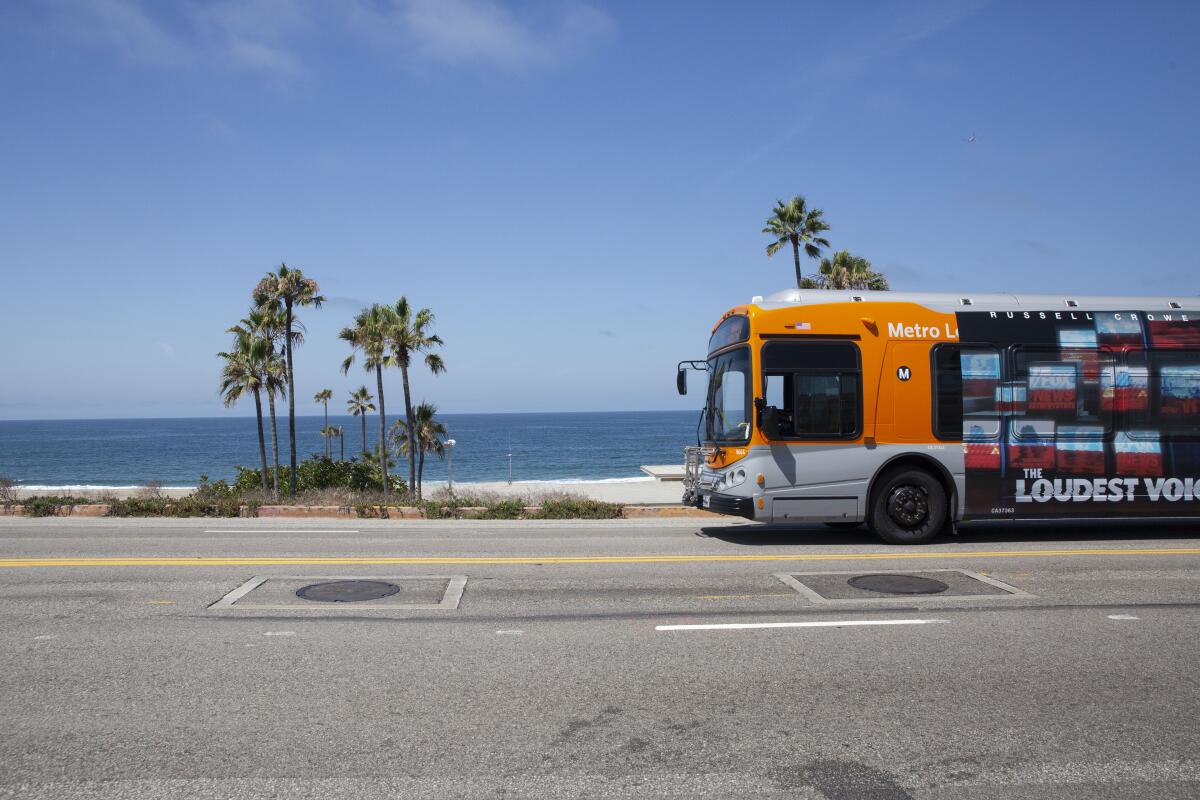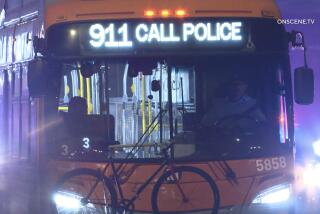Riding the buses of Los Angeles: A beginner’s guide

One of my goals when I moved to Los Angeles in late January was to try to commute to work by mass transit. I knew it would put me in the minority in this city of freeways and traffic jams: Metropolitan Transportation Authority buses have lost more than a quarter of their passengers over the past decade, and fewer than 3% of residents take more than 25% of the region’s transit trips. But I wanted to buck the tide, especially since the cost of commuting in L.A. — $1.75 for a single ride (and just $1 on Beach Cities Transit) — is remarkably cheap compared with other major cities.
It was an occasional challenge and sometimes — as when I just missed a bus and knew another one wouldn’t come for half an hour or 45 minutes — I would revert to Uber or Lyft. But mostly I did manage by bus, and I learned a few strategies along the way. Here are a few tips for those who haven’t yet abandoned their cars but are thinking about doing so.
Get a TAP card. There is a dizzying array of bus lines in the Los Angeles area, from the main L.A. Metro network system to Beach Cities Transit, the Big Blue Bus or the Glendale Beeline. All take the TAP card, which can be bought (for a one-time cost of $2) at vending machines at most Metro stations as well as online. It saves having to scramble for exact change each time you board and can even result in an unexpected free ride. Over the course of the past few months, there were at least a half dozen times that I and other passengers on various bus lines were waved on by the driver without paying because the TAP card reader wasn’t working.
Download the Moovit app. I found the website of the L.A. Metro system totally confusing and practically useless when trying to plan my commutes. But a few weeks into my move, after I had accumulated a museum-worthy stack of timetables and printouts of various routes, I finally stumbled upon the Moovit app. Type in your current location (or where you want to leave from) and where you want to go, and it will immediately show what the nearest bus or Metro line might be, and when the next train or bus is scheduled to arrive, predicting the latter with remarkable accuracy.
Enjoy the view: Almost every single one of my bus commutes took longer than the same trip would have if I had driven a car or taken Uber, largely because the buses rarely took direct routes and instead meandered around the residential streets of metro Los Angeles, lengthening the trip but providing impromptu tours of Southern California. I experienced gorgeous views of Dockweiler State Beach from the 115, rambled through the beautifully landscaped neighborhoods of Manhattan Beach and Lawndale on the 102, rode past the Ballona Wetlands and the Loyola Marymount University campus on the Big Blue Bus, and took an architectural tour of the historic office buildings and imposing churches of downtown Los Angeles on the Silver Line. It was a pleasant way to start the day or a relaxing way to end one.
Be chill: There can be a casualness to the operation of the buses — and timetables that sometimes feel like wishful thinking (8:43 might mean 8:50 or it might mean 8:39) — that might drive anyone who is a stickler for punctuality a bit crazy. But on the 109, which travels from South Redondo Beach to LAX, winding its way through Hermosa Beach, Manhattan Beach and El Segundo, and which I took most frequently, I was charmed by how almost everyone on the morning commute seemed to know one another as well as the driver, often swapping stories about how they spent their weekends, or sharing details like a recent engagement or the birth of a grandchild. (And one woman rode the bus almost every morning, from beginning to end, seemingly just as a way to start the day.) At times, it felt as if I had traveled back in time to Mayberry, and that meant embracing the fact that generosity might trump punctuality. Like when the bus suddenly halted between two stops, to let a passenger jump off to drop a letter in a mailbox and then jump back on, or when another driver pulled over shortly after we departed a stop as he realized that a would-be passenger, struggling with two bags of groceries, had just missed the bus and was about 20 yards behind us. In New York, you could have hobbled on crutches for three blocks only to reach the bus stop at the exact moment the doors closed, and the driver would have looked you straight in the eye and driven on.
Be chill, Part 2: One fact of life about riding the buses in L.A. is that you will occasionally be sharing the space with the homeless and the mentally ill. The former will undoubtedly bring a certain fragrance to the ride; the latter will occasionally yield a challenging situation. Once on a morning commute on a Big Blue Bus from Venice, a clearly disturbed woman confronted an African-American man sitting across from her, screaming racist and homophobic slurs, at one point hovering over him, no more than 6 inches from his face. This went on for 15 minutes or more — the woman’s voice getting louder and louder, her taunts even more insulting — but the man sat there without showing any reaction and the bus driver completely ignored what was going on. The other passengers — there were maybe eight of us — exchanged glances, but no one did anything. Finally, I had enough. At the next stop, as the back door opened, I yelled at her to stop what she was doing or get off the bus. She turned to me, smiled, and then started hurling a new set of insults and slurs my way. But all of us were then saved when the two dogs she had with her ran out the bus door, and she scrambled to follow them. As she did, she turned one more time in my direction and spat on me. Next time, I think I’ll keep my mouth shut.
More to Read
Sign up for The Wild
We’ll help you find the best places to hike, bike and run, as well as the perfect silent spots for meditation and yoga.
You may occasionally receive promotional content from the Los Angeles Times.










